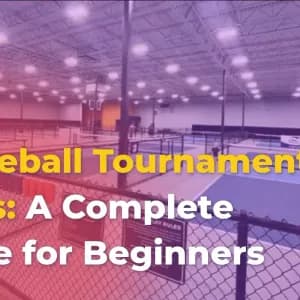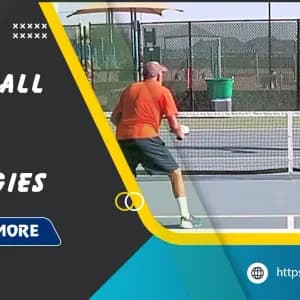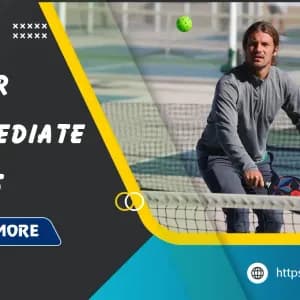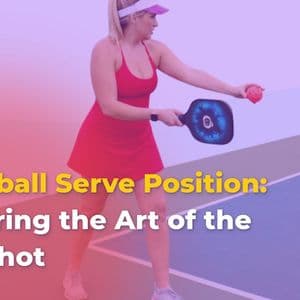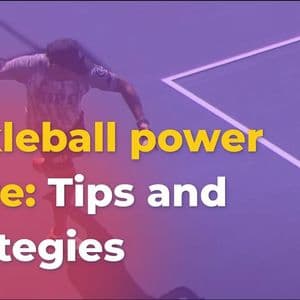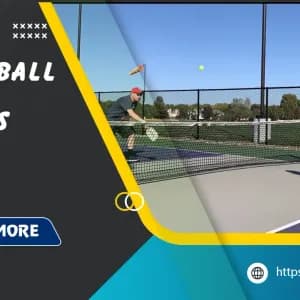Mastering the fundamentals: Anatomy of a legal pickleball serve
Grasping the intricacies of a legal serve in pickleball is essential for both novice and seasoned players. This understanding not only sharpens one’s skills but also fosters fair play and sportsmanship. At the foundation of a legal serve are precise rules concerning underhand strokes, foot placement, and the physical execution of the serve itself. Each component plays a pivotal role in determining whether a serve rubberbands into legality or spirals into a fault.
The underhand rule
Central to the concept of a legal serve is the underhand rule. Unlike in tennis, where the overhand serve dominates, pickleball requires players to use an underhand motion. This regulation levels the playing field, preventing any potential unfair advantages that could arise from a powerful overhead strike.
The paddle's contact with the ball must occur below the server's waist level, an act reminiscent of a catcher preparing to launch a perfect throw to second base it's all about precision. Additionally, at the moment of contact, the paddle's head must remain below the wrist. Should it breach this parameter, the serve becomes illegal, regardless of the power or spin evident.

The upward arc
The trajectory of the serve is another critical element, demanding an upward motion rather than a downward chop. Imagine a graceful ballet dancer lifting their arms to the sky; it’s all about elevation. An upward arc is essential, as it not only accommodates the rules but also enhances the serve's effectiveness. Too many players neglect this aspect, inadvertently falling prey to the temptation of a downward swing, which can impose a burden on their overall performance.
Clean contact: No tricks allowed
Perhaps the most straightforward yet often overlooked rule is the necessity of clean contact. Players are prohibited from scooping, carrying, or manipulating the ball in any way. An illegal touch can invoke a sense of betrayal, not only within the infraction itself but also in how it tarnishes the game’s integrity. Observing this rule mirrors the value of honesty in life: a clean hit fosters trust among players, ensuring every point is earned on merit rather than circumstantial advantage.
Foot placement: Staying behind the line
Foot faults are a glaring mistake many players encounter. It’s crucial that servers remain behind the baseline, with both feet planted securely. Stepping on or over the line during the serve is considered a violation and can quickly turn a promising rally into a missed opportunity. Similar to the way a sculptor chisels away to find the perfection within marble, players must mold their positions with diligence and care to ensure an effective and legal serve.

Common pickleball illegal serves: Mistakes to avoid
The art of serving is nuanced, and with so many rules to consider, it’s easy for players to stumble into common pitfalls. Understanding these mistakes is the first step toward mastery and maintaining a well-regulated game.
Foot fault: Watch your step!
Foot faults are among the most frequent infractions committed on the court. Players, eager to begin the match, may neglect to maintain their position behind the baseline. As if balancing a tightrope, the server must ensure that their feet do not cross the line until the moment of contact. This single misstep can transform a legal serve into an automatic fault, gifting the opposing player a point a devastating oversight that can disrupt a player’s momentum.

Serving out of bounds: Aiming for the right target
Another common faux pas is serving out of bounds. The serve must land within the diagonally opposite service court, and missing this target can lead to disappointment. Envision a marksman aiming at a distant bullseye; precision is paramount. Players must be acutely aware of their serving angles and trajectories to avoid hitting the ball outside the designated area striking out will grant the opponent an easier opportunity to capitalize on their error.
Drop serve violations: A controlled release
The drop serve is a wonderfully strategic option that has gained popularity among players in recent years. However, many fail to realize that there are specific rules associated with it as well. The ball should be dropped from a natural height and struck cleanly before it bounces. If the player uses downward propulsion or manipulates the ball in any way, the serve becomes illegal. Successfully executing a legal drop serve requires finesse, akin to a chef precisely timing the release of food to achieve the perfect sear.
Contact point errors: Keeping it low
Ultimately, contact point errors can render a serve illegal if the paddle strikes the ball above the player’s waist. Aiming for the navel level is advisable for consistency and compliance with the rules. Striking too high can lead to penalties, forcing players to recalibrate their technique and develop an instinct for better placement.
The drop serve: A legal and strategic option
The advent of the drop serve introduced an element of strategy and flexibility into the game. Understanding how to execute it effectively can provide players with a valuable edge during matches.

Executing a legal drop serve
When executed correctly, a drop serve can be a game-changer. To master this technique, players should focus on the motion of dropping the ball directly in front of them before striding forward with a clean strike. Precision in paddle motion is imperative, as a hasty or uncontrolled serve could quickly devolve into a fault. Many players find success through drills that emphasize timing and placement, allowing them to become more comfortable with this intriguing skill.
Serving in doubles: It's a team effort
Doubles play adds another layer of complexity to the serving game. Coordination and communication are paramount as partners work to execute legal serves effectively.

Serving order and rotation
In a doubles match, understanding serving order and rotation is crucial. Players must be aware of who is serving and receiving at any given point to avoid disqualification. An improper serving sequence can lead to penalties, throwing off the rhythm of the game. Thus, engaging in a team huddle before the match can solidify understanding and clarify expectations, ensuring seamless gameplay.
Switching sides: The right move after a point
Once a point is won, switching sides maintains fairness and prevents player advantage related to factors like wind or sun position. This strategic shift represents the balance of competition, reflecting the principles of sportsmanship. Players should view this as an opportunity to regroup, strategize, and adjust their serves according to their observation of the opponents’ weaknesses.
Debunking common serving myths
The sport is rife with misconceptions that can lead to misunderstandings about correct procedures and rules. It’s essential for players to distinguish fact from fiction.
Swinging and missing: Not always a fault
One frequent myth is that a missed serve is automatically a fault. Contrary to this belief, the precise 10-second rule allows players a grace period to attempt the serve once they’ve been called. This means that even if they swing and miss, they can retake their position without penalty as long as they comply with the timing.
Netting the serve: A legal let?
The notion that serves hitting the net are always a fault is misleading. Known as a let serve, the rules permit the ball to hit the net and land correctly in the service box without penalty. This characteristic demonstrates the element of forgiveness in pickleball, reminding players of the sport's inherent generosity and the spirit of fair play.

Consequences of illegal serves: The price of a fault
Having addressed the fundamental nuances surrounding serving, it’s vital to recognize the consequences of illegal serves. Understanding these repercussions can motivate players to refine their technique and adhere to the laws of the game.
Loss of serve: Turning the tables
An illegal serve can result in a loss of serve. This consequence can be particularly demoralizing, especially in competitive matches. Like a basketball player missing a free throw, the server may feel the weight of disappointment while inviting competitive spirits to rise. The balance shifts, and the opponent is granted the chance to capitalize on the oversight, underscoring the importance of focused execution.
Point to the opponent: A costly mistake
Beyond the loss of serve, illegal serves can directly reward opponents with points. Such situations can chip away at the morale of the serving team, making focus and mental resilience essential to navigate through adversity. A single moment of inattentiveness could spark a chain reaction that defines the ultimate outcome of the match.
Elevating your serve: Tips for improvement
A commitment to continuous improvement is crucial for all players who aim to elevate their skill level. With diligent practice, understanding nuances, and seeking feedback, even the simplest serves can become masterpieces on the court.
Practice makes perfect: Consistency is key
Devoting time to practicing serves can help players establish muscle memory, making correct execution second nature. Emphasizing regular drills that focus on accuracy and consistency will reinforce proper serving techniques. repeating these practices can lead to serving excellence, much like a pianist refining a challenging piece through repetition until precision shines.
Seeking expert feedback: Coaching and tips
Engaging with experienced players or coaches can provide fresh perspectives and constructive feedback. Utilizing video analysis can also clarify areas in need of modification, ensuring that the player's serves are optimized for performance. Much like an artist honing their craft, seeking insight allows players to flourish and develop their unique serving identity.
Serving with style: Exploring legal variations
Once players have honed their basic skills, they may wish to explore advanced techniques that can enhance their serving style and effectiveness.
Beyond the basics: Different serving styles
With techniques like the sidearm serve or spin serve, players can broaden their repertoire and confuse opponents. These creative variations allow for deception, providing a strategy that goes beyond traditional serves. Seeing the court as a canvas can foster an artistic approach to serving infusing each play with personality and flair.
Serving strategy: Placement and deception
Understanding target areas and exploiting opponent weaknesses can turn serves into powerful tools for control. A well-placed serve can dictate play pace, maneuver opponents into vulnerable positions, and lay the groundwork for winning strategies. Much like a chess player anticipating an opponent's move, strategic serving allows players to remain a step ahead, turning serve advantage into game advantage.
Staying up-to-date: Resources for continued learning
To remain competitive, players must stay informed about evolving rules and methodologies. Resources available today can support continuous growth in the sport.
USA Pickleball official rules: The definitive guide
The USA Pickleball rulebook serves as the definitive resource for understanding current regulations and standards. Familiarizing oneself with the rulebook not only prepares players for the various scenarios that may arise during gameplay but also reinforces the fundamental principles of fair competition.
Visual learning: Videos and demonstrations
In an age where visual content dominates, platforms like YouTube offer vast catalogs of tutorials and demonstrations. Engaging with these films can provide players with practical insights, helping them visualize concepts and refine their serves. By incorporating these resources into their training regimen, players can elevate their understanding and performance on the court.
Conclusion
In navigating the intricate world of pickleball serves, understanding and adhering to the regulations of illegal serves is vital for maintaining the integrity of the game. As players become more acquainted with the rules ranging from foot placement to contact point they will enhance not only their own skills but also elevate the overall experience for fellow competitors. By fostering a culture of awareness and sportsmanship, the beautiful game of pickleball continues to flourish and attract enthusiasts around the world. Whether served with simplicity or style, let each player's serve carry the promise of fair play and spirited competition!


